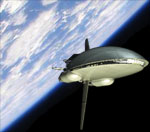
Worlds
Worlds are the metric by which an empire is measured. They are the consumers and the producers. They are the land and the people. They are the essence of the empire. To rule an empire is to love each world as much as you love power. Losing one is a tragedy. And it never hurts to gain more.
Not every world is the same, of course; some are cold and arid wastelands, others are fertile oases teeming with life. There are those with the technology to travel to the stars, while others have just reached their "industrial revolution." Many factors contribute to making each world unique, but the main criteria by which worlds are classified are: population, efficiency, class, technology level, and type.
Population
The population of a world is the most important factor affecting world production. The amount of resources that a given world can produce is dependent on the population of that world. Population increases exponentially until it reaches the optimum level for the world's technology level. Thereafter, it increases linearly.
Efficiency
The efficiency of a world, an indication of the local government's bureaucratic competence, has a strong effect in industrial production and defense. It is expressed as a percentage, 100% being the maximum.
Efficiency increases slightly each year, but many events may decrease it. A newly conquered world begins with a low efficiency, as the government has recently been established. Similarly, any changes in the type of the world will reduce its efficiency, since wholesale changes in the economy are being made.
Class
Each world can be placed into a category that represents the world's basic environment. This category, called the class of the world, is useful in determining how hospitable the world is to human life and how appropriate the world is to a particular industry. Rocky and barren worlds, for instance, are not ideal for life in general. Colonies on those kinds of worlds often need a great deal of external help. Other classes have special biospheres, such as worlds with hostile life-forms or extreme weather conditions.
The world classes table describes each class in greater detail.
Technology Level
Another important difference between worlds is their technology level. Some worlds are pre-atomic societies, while others harbor ancient cultures possessing the power to construct giant and powerful starships. Obviously these two worlds will react very differently when approached by a large fleet of jumpships. more importantly, even within the empire some worlds will be more advanced than others. It would clearly be unrealistic to expect a pre-atomic society to be able to build interstellar transports for the empire. At best such worlds might be directed to mine metals out of the ground. These worlds, however, because they are guided by a more advanced power, will make frequent and sudden advances in technology.
The technology level table describes the different levels.
The technology level of a world is one of its most important characteristics. In addition to determining what things it can produce, the technology level also determines how large a population the planet can support and how well a planet can defend itself. For example, a starship-level empire attacking an atomic-level world will have an advantage, even if both sides have the same number and types of ships. The more advanced empire will have better instruments, better training, and even better tactics. The progression is not constantly linear, of course; once a world has developed basic atomic power and space travel, the difference in technology will not be as drastic.
Type
Another distinction between worlds is their type. All independent worlds, by definition, are self-sufficient and produce every kind of resource (materials, ships, etc). Worlds that are part of an empire, however, are under the control of that empire and may concentrate on only a few resources. The emperor or empress could, for instance, decide that a certain planet is to produce jumpships and nothing else. In that case, that planet would produce only enough supplies, metals, chemicals, and trillum to support its industry.
Choosing the type of a world is the primary means by which an empire controls the production and contributions of each world. Once the type is set, the world will automatically balance its industry to comply with the requirements of the type. For example, a metal mining world will adjust its industries to concentrate on producing metals. A starships world will concentrate on building starships.
The world types table describes each type in greater detail.
Next: Materials
